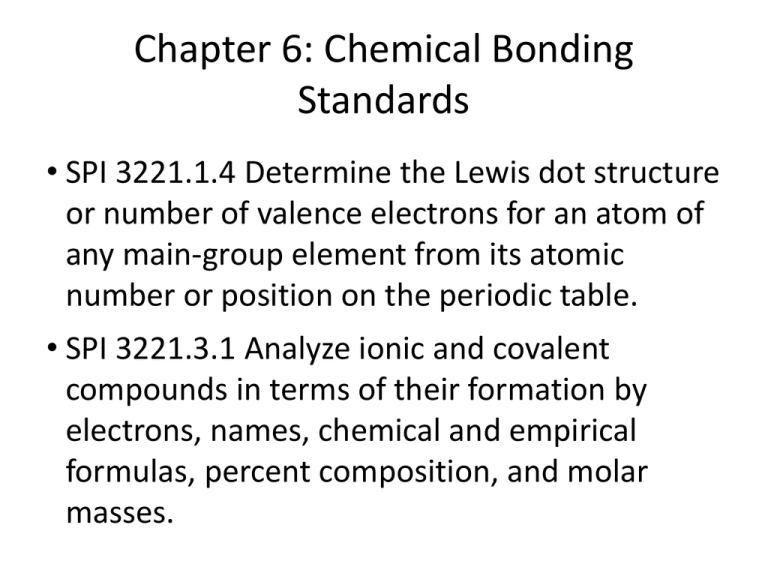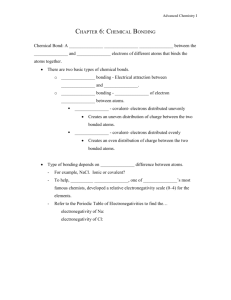Chemical bond
advertisement

Chapter 6: Chemical Bonding Standards • SPI 3221.1.4 Determine the Lewis dot structure or number of valence electrons for an atom of any main-group element from its atomic number or position on the periodic table. • SPI 3221.3.1 Analyze ionic and covalent compounds in terms of their formation by electrons, names, chemical and empirical formulas, percent composition, and molar masses. Chapter 6 Section 1 Introduction to Chemical Bonding Ch. 6.1 Objectives 1. Define chemical bond. 2. Explain why most atoms form chemical bonds. 3. Contrast ionic and covalent bonding. 4. Classify bonding type according to electronegativity (EN) differences. Chapter 6 Section 1 Introduction to Chemical Bonding Lesson Starter • Imagine getting onto a crowded elevator. Many people will experience a sense of being too close together. • When atoms get close enough, their outer electrons repel each other. At the same time, however, each atom’s outer electrons are strongly attracted to the nuclei of the surrounding atoms. • The degree to which these outer electrons are attracted to other atoms determines the kind of chemical bonding that occurs between the atoms. Chapter 6 Section 1 Introduction to Chemical Bonding Chemical Bond • Chemical bond- a mutual electrical attraction between the nuclei and valence electrons of different atoms that binds the atoms together. – Most elements have higher energy while they are lone atoms, they actually lower energy when they bond as it fills their outer shell of electrons. – Bonding makes most atoms happy and less energetic. Visual Concept Chapter 6 Section 1 Introduction to Chemical Bonding Ionic Bonding • Atoms prefer to gain or lose electrons to become more stable. – Forming cations or anions • Ionic bonding- chemical bonding that results from the electrical attraction between cations and anions. – Occurs between a metal and a nonmetal. Visual Concept Chapter 6 Section 1 Introduction to Chemical Bonding Covalent Bonding • Covalent bonding- bonding resulting from the sharing of electron pairs between two atoms. – Neither atom gains or loses, they both are happy because they have a full outer shell by sharing. – Occurs between nonmetals. – Why? Visual Concept Chapter 6 Section 1 Introduction to Chemical Bonding Comparing Polar and Nonpolar Covalent Bonds • Ionic vs. Covalent depends on how strongly each atom pulls on those electrons (Electronegativity). • To determine find the difference between the electronegativities of both atoms. • The difference will tell you if it’s an ionic or covalent bond. Visual Concept Chapter 6 Section 1 Introduction to Chemical Bonding Using Electronegativity Difference to Classify Bonding • If the difference is between 0-0.3 it’s a non-polar covalent bond. – Nonpolar covalent bond- a bond where the bonding electrons are shared equally by the bonded atoms (balanced charge). • If the difference is between 0.3-1.7 it’s a polar covalent bond. – Polar covalent bond- a bond where there is an unequal attraction for the shared electrons (uneven distribution of charge). • If the difference is between 1.7-3.3 it’s an ionic bond. Visual Concept Chapter 6 Section 1 Introduction to Chemical Bonding Chemical Bonding practice •Use EN values listed in Figure 20 on page 161, and Figure 2 on page 176, to classify bonding between sulfur, S, and the following elements: 1. hydrogen, H 2. cesium, Cs 3. chlorine, Cl • In each pair, which atom will be more negative? Chapter 6 Section 1 Introduction to Chemical Bonding Chemical Bonding practice •What type of bonding would be expected between the following atoms? a) Li and F b) Cu and S c) I and Br • Which element would have the higher negative character (EN)? •HW: Please answer the objective questions for this section and do the vocabulary for 6.2.




